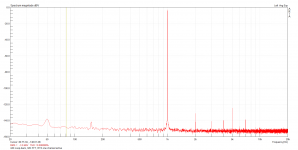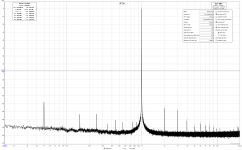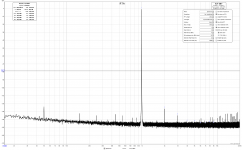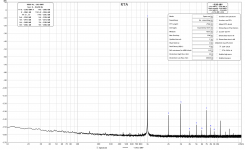Or the attenuation is set wrong..
I do have signal with RTX in loopback with -160+dBFs noise floor..
I do have signal with RTX in loopback with -160+dBFs noise floor..
Unfortunately not - att settings was sett correct (100mV, 316mV and 1V) on analyzer and on RAW, corresponding to level of measured signal.
Also, everything is in dBV and not in dBFs!
But beside that, is evident the difference in noise floor.
"I do have signal with RTX in loopback with -160+dBFs noise floor.."
Could you specify exactly how you have sett RTX for that result?
I would like to confirm that on my RTX, maybe is relay something wrong with mine.
Also, everything is in dBV and not in dBFs!
But beside that, is evident the difference in noise floor.
"I do have signal with RTX in loopback with -160+dBFs noise floor.."
Could you specify exactly how you have sett RTX for that result?
I would like to confirm that on my RTX, maybe is relay something wrong with mine.
Last edited:
Unfortunately I am on the road.. had to dig up other people's graphs..
Here it is one from lemon, I hope he don't mind..
Post 1773
The cursor snows -148dBV noise floor - at 80Hz.. at 10 kHz it is < -150dBV..
He used 44kHz , very probably proper 24bit resolution, 32ksamples FFT.
I used to use much higher FFT resolution, so deeper noise floor..
Here it is one from lemon, I hope he don't mind..
Post 1773
The cursor snows -148dBV noise floor - at 80Hz.. at 10 kHz it is < -150dBV..
He used 44kHz , very probably proper 24bit resolution, 32ksamples FFT.
I used to use much higher FFT resolution, so deeper noise floor..
Attachments
Last edited:
Now with 256k FFT - 339A still almost 10dBV better noise floor.
The first series of measurements was with 32k FFT.
https://www.diyaudio.com/forums/attachment.php?attachmentid=794599&stc=1&d=1573688257
https://www.diyaudio.com/forums/attachment.php?attachmentid=794600&stc=1&d=1573688257
The first series of measurements was with 32k FFT.
https://www.diyaudio.com/forums/attachment.php?attachmentid=794599&stc=1&d=1573688257
https://www.diyaudio.com/forums/attachment.php?attachmentid=794600&stc=1&d=1573688257
Attachments
You have to consider the unused, 'burned' up dynamic range, when You set the RTX 6001 in loopback..
Given that You test at 0dBV output level, why don't You use the RTX6001 in the correct, 0dBV range settings?
Take into account, that while setting the Rtx at 10dBV (and use it at -10dB Fs dac setting) - you have 'stolen' this extra attenuation from the dac's output.
While your external instrument (339 oscillator) do not suffer this 'holdback'...
Given that You test at 0dBV output level, why don't You use the RTX6001 in the correct, 0dBV range settings?
Take into account, that while setting the Rtx at 10dBV (and use it at -10dB Fs dac setting) - you have 'stolen' this extra attenuation from the dac's output.
While your external instrument (339 oscillator) do not suffer this 'holdback'...
I would suggest that a correct comparison would be to set the test signal level at -3dB, and use the RTX6001 with 0dBV / 0dBV settings.
Now the difference that remains still ( if any) will be more real..
Ciao, George
Now the difference that remains still ( if any) will be more real..
Ciao, George
There are so many issues comparing noise and distortion with FFT's.
1) Make sure the input level is the same.
2) With a digital source the distortion goes down as you reduce the level (dBFS). Typically the best results are at -12dB to -18 dB. However the SNR degrades by the same amount.
3) Looking at the noise floor on an FFT is really misleading without knowing a whole lot of details- FFT resolution, windowing function etc. Use the software's calculator to get a number since it will add the amount in each bin in the listed bandwidth. Still you must compare like for like, level for level and bandwidth for bandwidth.
4) Typically a well designed analog oscillator (HP339, KH4400, Victor) will have significantly lower distortion and noise than any DAC but its limited to one or maybe 2 waveforms/signals.
1) Make sure the input level is the same.
2) With a digital source the distortion goes down as you reduce the level (dBFS). Typically the best results are at -12dB to -18 dB. However the SNR degrades by the same amount.
3) Looking at the noise floor on an FFT is really misleading without knowing a whole lot of details- FFT resolution, windowing function etc. Use the software's calculator to get a number since it will add the amount in each bin in the listed bandwidth. Still you must compare like for like, level for level and bandwidth for bandwidth.
4) Typically a well designed analog oscillator (HP339, KH4400, Victor) will have significantly lower distortion and noise than any DAC but its limited to one or maybe 2 waveforms/signals.
@bozidarms: take look here. Scroll down and you'll find a loopback spectrum that was measured with your device (i.e., the one you bought from me). The noise floor is at about 10 nV, or about -160 dB below the fundamental. Maybe your (not-so) "bad" noise floor is just a simple matter of how you set up your software, or maybe the loopback wiring.
Demian is correct as usual. It’s also not that surprising that a specialized oscillator is better performing than an AK4490.
In my measurements with the RTX 6001 the noise floor of the generator was more or less the noise floor of the analyzer (with shorted or open inputs).
Your loopback should be "better", but I have no idea what is going wrong for the moment.
Your loopback should be "better", but I have no idea what is going wrong for the moment.
I dare to say that a good DAC with properly digitally compensated harmonic distortions could compete with a good analog oscillator in plain THD (not in THD+N, of course).
Hi Demian
Sure, all signals was the same and measured under same circumstances (levels, scales...).For signals over 1V the difference is not so evident, but for low level signals the difference is enormous - look at curves for 6mV input signal.
THD+N 71:53, THD 111:89
There is one difference over 20dB in noise floor - conditions in measurements was the same!
This low noise floor and ability to measure low levels is that what wonder me at most, not a competition between the two oscillators.
Or to say that other way - the noise floor and SNR of 339A is always better, specially on signals under 1V. Simply i haven't expect that, have tough undoubtedly that RTX oscillator is superb in every way.😱
https://www.diyaudio.com/forums/attachment.php?attachmentid=794702&stc=1&d=1573724182
https://www.diyaudio.com/forums/attachment.php?attachmentid=794703&stc=1&d=1573724182
https://www.diyaudio.com/forums/attachment.php?attachmentid=794704&stc=1&d=1573724182
https://www.diyaudio.com/forums/attachment.php?attachmentid=794705&stc=1&d=1573724182
https://www.diyaudio.com/forums/attachment.php?attachmentid=794706&stc=1&d=1573724182
https://www.diyaudio.com/forums/attachment.php?attachmentid=794707&stc=1&d=1573724182
https://www.diyaudio.com/forums/attachment.php?attachmentid=794708&stc=1&d=1573724182
https://www.diyaudio.com/forums/attachment.php?attachmentid=794709&stc=1&d=1573724182
Sure, all signals was the same and measured under same circumstances (levels, scales...).For signals over 1V the difference is not so evident, but for low level signals the difference is enormous - look at curves for 6mV input signal.
THD+N 71:53, THD 111:89
There is one difference over 20dB in noise floor - conditions in measurements was the same!
This low noise floor and ability to measure low levels is that what wonder me at most, not a competition between the two oscillators.
Or to say that other way - the noise floor and SNR of 339A is always better, specially on signals under 1V. Simply i haven't expect that, have tough undoubtedly that RTX oscillator is superb in every way.😱
https://www.diyaudio.com/forums/attachment.php?attachmentid=794702&stc=1&d=1573724182
https://www.diyaudio.com/forums/attachment.php?attachmentid=794703&stc=1&d=1573724182
https://www.diyaudio.com/forums/attachment.php?attachmentid=794704&stc=1&d=1573724182
https://www.diyaudio.com/forums/attachment.php?attachmentid=794705&stc=1&d=1573724182
https://www.diyaudio.com/forums/attachment.php?attachmentid=794706&stc=1&d=1573724182
https://www.diyaudio.com/forums/attachment.php?attachmentid=794707&stc=1&d=1573724182
https://www.diyaudio.com/forums/attachment.php?attachmentid=794708&stc=1&d=1573724182
https://www.diyaudio.com/forums/attachment.php?attachmentid=794709&stc=1&d=1573724182
Attachments
-
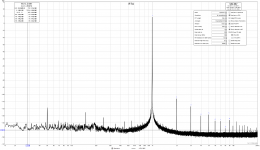 339A signal 3V, 9,54dBV, -0,44dbFS on 3,16V RTX analyzer scale.png152.2 KB · Views: 306
339A signal 3V, 9,54dBV, -0,44dbFS on 3,16V RTX analyzer scale.png152.2 KB · Views: 306 -
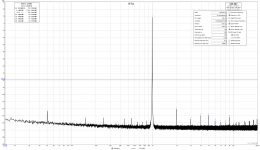 RTX signal 3V, 9,54dBV, -0,44dbFS on 3,16V RTX analyzer scale.png139.6 KB · Views: 322
RTX signal 3V, 9,54dBV, -0,44dbFS on 3,16V RTX analyzer scale.png139.6 KB · Views: 322 -
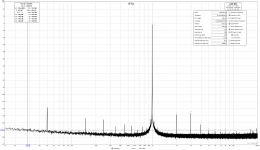 339A signal 0,8V, -2dBV, -12dbFS on 3,16V RTX analyzer scale.png140.8 KB · Views: 305
339A signal 0,8V, -2dBV, -12dbFS on 3,16V RTX analyzer scale.png140.8 KB · Views: 305 -
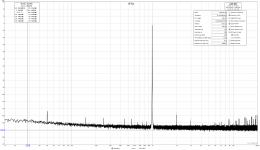 RTX signal 0,8V, -2dBV, -12dbFS on 3,16V RTX analyzer scale.png142.1 KB · Views: 303
RTX signal 0,8V, -2dBV, -12dbFS on 3,16V RTX analyzer scale.png142.1 KB · Views: 303 -
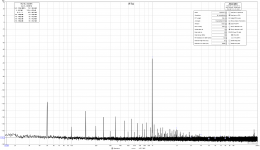 339A signal 2mV, -53,9dBV, -33,98dbFS on 0,1V RTX analyzer scale.png137.3 KB · Views: 291
339A signal 2mV, -53,9dBV, -33,98dbFS on 0,1V RTX analyzer scale.png137.3 KB · Views: 291 -
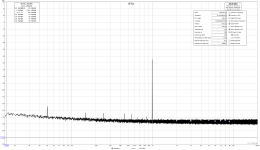 RTX signal 2mV, -53,9dBV, -33,98dbFS on 0,1V RTX analyzer scale.png134.8 KB · Views: 90
RTX signal 2mV, -53,9dBV, -33,98dbFS on 0,1V RTX analyzer scale.png134.8 KB · Views: 90 -
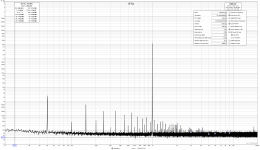 339A 6mV signal in square rootHz on 0,1V RTX scale.png146.5 KB · Views: 103
339A 6mV signal in square rootHz on 0,1V RTX scale.png146.5 KB · Views: 103 -
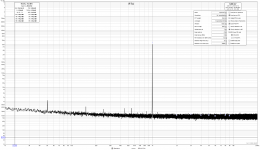 RTX 6mV signal in square rootHz on 0,1V RTX scale.png141.7 KB · Views: 100
RTX 6mV signal in square rootHz on 0,1V RTX scale.png141.7 KB · Views: 100
Can someone please, for comparison purposes, make loopback measurements on own RTX with signals under 1V (till few mV)?
I only ask myself why is noise floor and SNR sometimes less, sometimes more but always better on 339A oscillator, and i speak here in difference over 20dB?
Last edited:
On RTX - is there analog attenuation, or digital, or combination? Analog attenuation at the output reduces noise floor (both the signal and noise are attenuated), while the digital one does not (only the signal is attenuated, in digital domain). I wonder if that mV output signal was analog-attenuated on RTX (like it was on the analog oscillator device).
- Home
- Design & Build
- Equipment & Tools
- DIY Audio Analyzer with AK5397/AK5394A and AK4490
